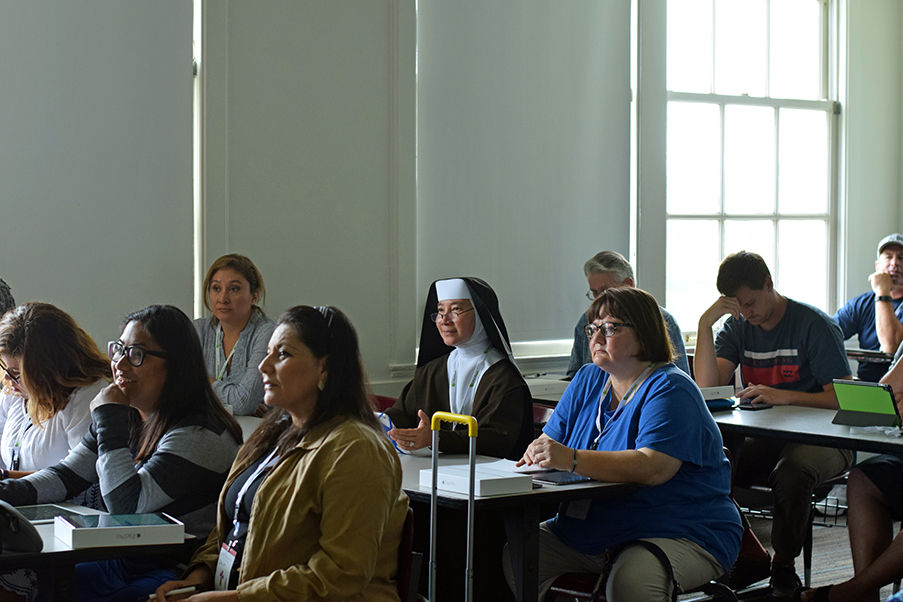Hundreds of employees and volunteers from parishes, schools and the offices of the Archdiocese of Los Angeles attended C3TC 2017 last month, a technology conference featuring more than 100 workshops exploring a variety of different topics focusing on one common goal: using everyday technological tools to enhance school, parish and archdiocesan ministries to promote the Catholic faith.
Auxiliary Bishop Robert Barron, episcopal vicar for the archdiocese, served as the keynote speaker for this year’s C3 conference, which was held at Loyola Marymount University in early August. He addressed both the beauty of the Church and also how today’s technology can be a catalyst to enhance evangelization efforts, for bringing faith and spirituality to the masses via websites, video, social media and more.
Bishop Barron shared several examples of awe-inspiring moments from his own life that he described as “objectively valuable” — meaning that the strength of its truth rearranges and redefines itself.
“It stops you in its tracks,” said Bishop Barron during his presentation.
He recounted why the game of baseball was objectively valuable to him as a young boy — the grandeur of a big stadium, the bright lights and the crisp white uniforms that were worn by the baseball players transformed him as a child.
“You start with the splendor of the game, just like we should do with the Church,” Bishop Barron told the audience.
He urged educators, clergy, youth ministers and laity to start with the beauty of the Church when using technology as a means of propagating the faith in an evangelical way.
“We need to recover our confidence and start talking about the beauty of God,” Bishop Barron explained.
Author, speaker and middle school English teacher Amy Cattapan utilizes her Instagram account to help promote the Catholic faith, which is one of the suggested methods Bishop Barron discussed during his keynote address.
“I start with the beauty of our faith and post pictures that are not too heavy handed,” she said.
Cattapan, who led a workshop about Instagram at the C3 conference, shared a personal story of making time for God while studying abroad. To her surprise, a German Catholic church was open during siesta time. She prayed the “Our Father” in German with gratitude for finding a church open at that time of the day.
“If God meets us where we are, then we need to meet our young people where they are,” said Cattapan.
And today’s young people are frequently on social media, she noted. The Church recognizes this reality and is working to capture the attention (and hearts) of more young people via social media. Teachers, youth ministers and parish leaders are increasingly using Instagram, Facebook and other social media outlets as tools to further engage their students, parishioners and ministers, to encourage them to be excited about participating in their parishes and the greater Church.
“Social media is a way to live your faith out loud,” said John Reyes, who is the director of education technology for the archdiocesan department of Catholic Schools.
For example, “Lent-a-thon” photos are popping up on Instagram reminding people to take time daily to do penance, read the Bible or do a charitable act. In addition, many parishes also post photos of people with ashes on their foreheads on Ash Wednesday, post messages to encourage parishioners to recite the rosary daily during the month of October, and post reminders of upcoming events and photos from recent gatherings.
“Just as Jesus used parables, images and words familiar with those around him, we, too, need to use what is familiar with our audience,” said Sister Jennifer Tecla, who is a Daughter of Saint Paul, to Angelus News. She presented a workshop titled “Faith Formation in Our Digital Age,” during which she encouraged educators to ask questions of the media, to recognize the validity of the messages being relayed and the values (or lack thereof) we are exposed to daily.
“Linking faith with media is what is called media mindfulness,” explained Sister Jennifer. “We, as Christians, are called to live our lives [being mindful of the messages we hear], because many times what the media ‘says’ is a value to live by, our faith can disagree with. This strategy in the classroom can be a great tool to educate children about how we are called to live our faith in our world.”
She pointed out that companies often spend “millions of dollars to make their product memorable” to potential consumers. In response, teachers, too, need to make faith formation memorable by linking everyday experiences with opportunities for positive faith experiences.
Many educators are utilizing technology to relate to students’ everyday experiences. Allyson Alberto, principal of Immaculate Heart of Mary School in Los Angeles, said that her students use iPads regularly for interactive applications for most school subjects, including religion.
“When you put an application to our faith and the students’ lives where they can relate Noah’s Ark to today’s society, it makes more sense to the students,” said Alberto, who also utilizes technology to help inspire her faculty members.
“Each week I send out everyday prayers on video to my staff,” she said. “It gives the teachers a three-minute retreat each day, which allows them to center themselves.”

